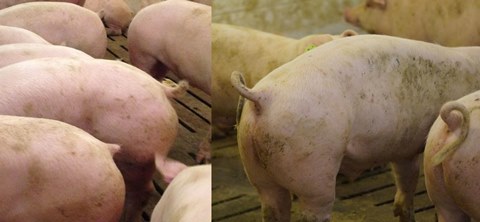By Yuzhi Li, Associate Professor of Swine Behavior and Welfare, and Alternative Swine Production

Tail biting is a common problem in growing-finishing pigs. Outbreaks of tail biting can cause major welfare complications of pigs with damaged tails, as well as considerable economic losses to pork producers. The prevalence of tail biting varies from farm to farm, ranging from 0% to 16% for pigs with docked tails, and 3% to 35% for pigs with whole tails. Although the incidence can be low on certain farms, outbreaks of tail biting are almost not predictable. Once an outbreak occurs, tail biting behavior can escalate rapidly, and it is difficult to prevent from further tail biting in the pen or room.
Preventions prior to an outbreak are common practices to avoid losses and implications caused by tail biting. Currently, the common prevention method for tail biting is tail docking which is usually performed when pigs are 1 to 7 days of age. Since tail docking can cause pain in pigs, performing tail docking on a routine basis is under scrutiny due to animal welfare concerns.
To re-evaluate consequences of raising pigs without tail docking, we conducted a study to compare pigs with and without tail docking. Two hundred forty pigs with average body weight of 55 lb were used. Pigs were housed in a conventional barn for 16 weeks. There were 4 pens of docked pigs, and 4 pens of undocked pigs, with each pen housing 30 pigs. Over the 16 weeks, 51.7% of undocked pigs and 7.5% of docked pigs experienced moderate to severe tail damage, indicating that without tail docking more pigs were victimized by tail biting. Undocked pigs experienced the first outbreak of tail biting 6 weeks earlier than docked pigs, suggesting that tail biting may start early and last longer when tail docking is not performed. As a consequence of tail damage, 18% of undocked pigs and 5% of docked pigs were removed to hospital pens in this study. For pigs that were not removed, growth performance was similar between docked pigs and undocked pigs.
Results of this study suggest that raising pigs without tail docking in a confinement housing system increases incidence of tail biting and tail damage, resulting in higher morbidity and compromised welfare of pigs. It seems that tail docking is still an efficient method to prevent tail biting in growing and finishing pigs under current commercial production conditions in the United States.
